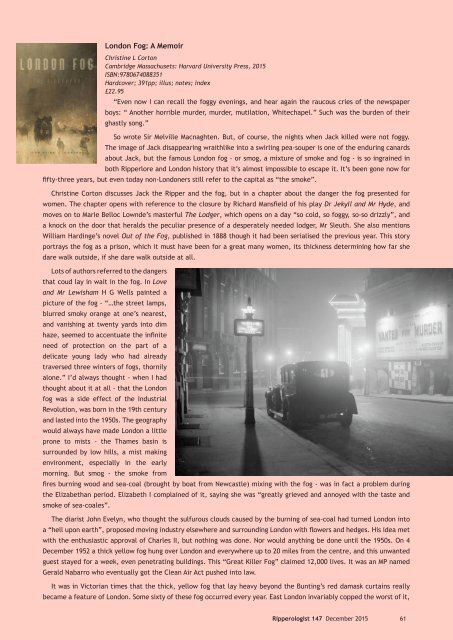Edmund Reid
nuhf574
nuhf574
Create successful ePaper yourself
Turn your PDF publications into a flip-book with our unique Google optimized e-Paper software.
London Fog: A Memoir<br />
Christine L Corton<br />
Cambridge Massachusets: Harvard University Press, 2015<br />
ISBN:9780674088351<br />
Hardcover; 391pp; illus; notes; index<br />
£22.95<br />
“Even now I can recall the foggy evenings, and hear again the raucous cries of the newspaper<br />
boys: “ Another horrible murder, murder, mutilation, Whitechapel.” Such was the burden of their<br />
ghastly song.”<br />
So wrote Sir Melville Macnaghten. But, of course, the nights when Jack killed were not foggy.<br />
The image of Jack disappearing wraithlike into a swirling pea-souper is one of the enduring canards<br />
about Jack, but the famous London fog - or smog, a mixture of smoke and fog - is so ingrained in<br />
both Ripperlore and London history that it’s almost impossible to escape it. It’s been gone now for<br />
fifty-three years, but even today non-Londoners still refer to the capital as “the smoke”.<br />
Christine Corton discusses Jack the Ripper and the fog, but in a chapter about the danger the fog presented for<br />
women. The chapter opens with reference to the closure by Richard Mansfield of his play Dr Jekyll and Mr Hyde, and<br />
moves on to Marie Belloc Lownde’s masterful The Lodger, which opens on a day “so cold, so foggy, so-so drizzly”, and<br />
a knock on the door that heralds the peculiar presence of a desperately needed lodger, Mr Sleuth. She also mentions<br />
William Hardinge’s novel Out of the Fog, published in 1888 though it had been serialised the previous year. This story<br />
portrays the fog as a prison, which it must have been for a great many women, its thickness determining how far she<br />
dare walk outside, if she dare walk outside at all.<br />
Lots of authors referred to the dangers<br />
that coud lay in wait in the fog. In Love<br />
and Mr Lewisham H G Wells painted a<br />
picture of the fog - “…the street lamps,<br />
blurred smoky orange at one’s nearest,<br />
and vanishing at twenty yards into dim<br />
haze, seemed to accentuate the infinite<br />
need of protection on the part of a<br />
delicate young lady who had already<br />
traversed three winters of fogs, thornily<br />
alone.” I’d always thought - when I had<br />
thought about it at all - that the London<br />
fog was a side effect of the Industrial<br />
Revolution, was born in the 19th century<br />
and lasted into the 1950s. The geography<br />
would always have made London a little<br />
prone to mists - the Thames basin is<br />
surrounded by low hills, a mist making<br />
environment, especially in the early<br />
morning. But smog - the smoke from<br />
fires burning wood and sea-coal (brought by boat from Newcastle) mixing with the fog - was in fact a problem during<br />
the Elizabethan period. Elizabeth I complained of it, saying she was “greatly grieved and annoyed with the taste and<br />
smoke of sea-coales”.<br />
The diarist John Evelyn, who thought the sulfurous clouds caused by the burning of sea-coal had turned London into<br />
a “hell upon earth”, proposed moving industry elsewhere and surrounding London with flowers and hedges. His idea met<br />
with the enthusiastic approval of Charles II, but nothing was done. Nor would anything be done until the 1950s. On 4<br />
December 1952 a thick yellow fog hung over London and everywhere up to 20 miles from the centre, and this unwanted<br />
guest stayed for a week, even penetrating buildings. This “Great Killer Fog” claimed 12,000 lives. It was an MP named<br />
Gerald Nabarro who eventually got the Clean Air Act pushed into law.<br />
It was in Victorian times that the thick, yellow fog that lay heavy beyond the Bunting’s red damask curtains really<br />
became a feature of London. Some sixty of these fog occurred every year. East London invariably copped the worst of it,<br />
Ripperologist 147 December 2015 61




